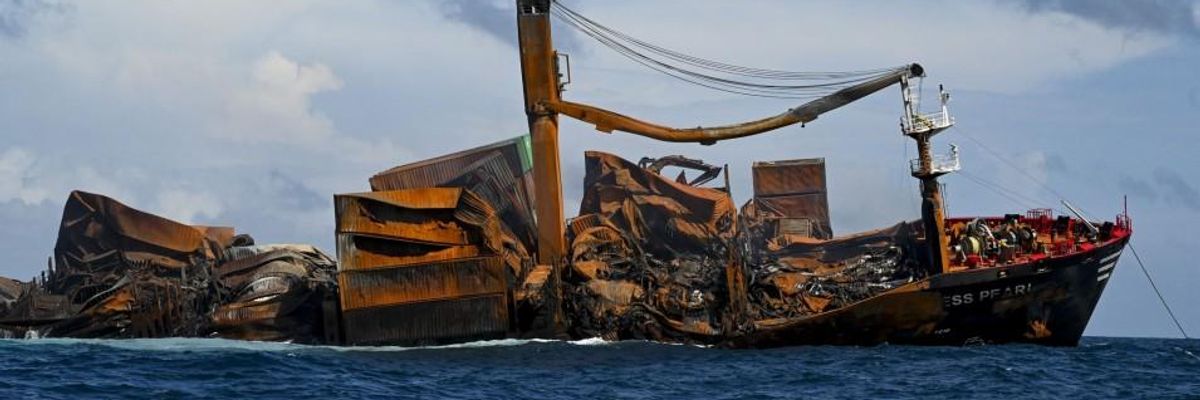A container ship carrying tons of hazardous chemicals sank off the Sri Lankan coast on Wednesday--the latest development in an ongoing marine disaster that began two weeks ago when an explosion aboard the vessel sparked a blaze that destroyed cargo, polluting the country's fishing waters and littering its beaches with plastic pellets.
As the ship began to sink early on Wednesday, "a salvage crew tried to tow the vessel to deeper water away from the coast," Reutersreported, "but the attempt was abandoned after several hours."
The towing of the fire-stricken ship "was stopped due to the rear end of the vessel hitting the sea bed," Sri Lankan Navy spokesman Captain Indika de Silva told the news outlet.
The Singapore-registered MV X-Press Pearl was "carrying 1,486 containers, including 25 tons of nitric acid along with other chemicals and cosmetics," according to Reuters. On May 20, the seacraft, which departed from the Port of Hazira in India on May 15, "was anchored about 9.5 nautical miles northwest of Colombo, waiting to enter the port" off Sri Lanka's west coast, Al Jazeera reported.
That's when an explosion onboard the ship engulfed the vessel in flames. Reuters reported that "containers laden with chemicals tumbled into the sea from the ship's deck as emergency crews sought to contain the blaze over the ensuing two weeks."
While the seacraft's 25-member crew was evacuated last week, it took firefighters until Tuesday to extinguish the fire.
As a result of the blaze, Al Jazeera noted, "tons of plastic pellets have swamped the island's coastline and rich fishing grounds, creating one of the biggest environmental crises in decades."
"Walking along some of these beaches in this vast stretch that has been affected, all you see is a blanket of white and black--they are the microplastic pellets mixed with a whole load of burnt, charred remains and debris material for dozens of kilometers as far as the eye can see," Al Jazeera's Minelle Fernandez said Tuesday.
Sri Lanka's Marine Environment Protection Authority chairman Dharshani Lahandapura described the situation as a "man-made disaster."
"This is an unfortunate incident for Sri Lanka," he told Al Jazeera. "It has negatively impacted the country in many ways. What we are doing right now is minimizing the negative impact."
According to Lahandapura, most chemicals on the ship--which the navy blames for the explosion and ensuing fire--were "highly reactive" and emitted through fumes and gases. "Some even dissolved in seawater," he added.
More destruction could be on the horizon. As de Silva of the Sri Lankan Navy told Al Jazeera, "Now our concern is about any oil spill."
"We are closely monitoring this and so far we have not detected any spill," he said. "It will be devastating if that happens, but we are taking all precautions."
Meanwhile, Sri Lanka's government on Wednesday "suspended fishing along a 50-mile stretch of the island's coastline, affecting 5,600 fishing boats, and hundreds of soldiers have been deployed to clean affected beaches," Reuters noted.
"The ship has dealt a death blow to our lives," Joshua Anthony, head of a regional fishing union, told the news outlet. "We can't go into the sea which means we can't make a living."
